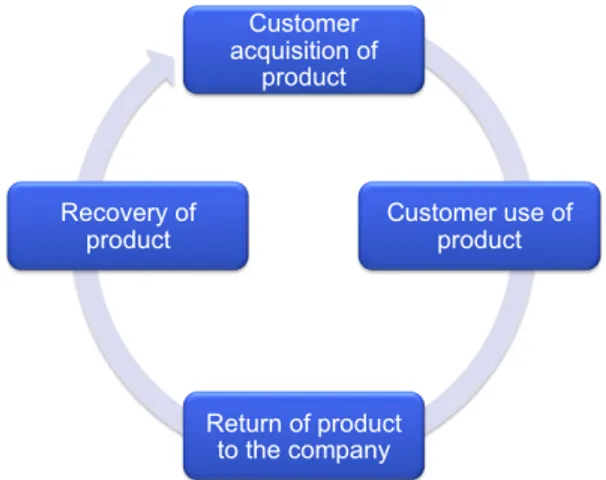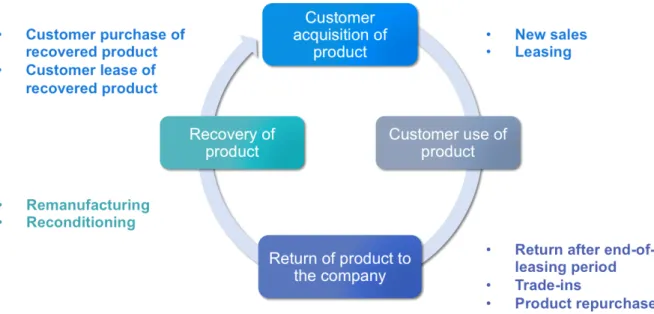Circular Return Strategies – A Sustainable
Approach To Reach Price Sensitive
Customers
Sophie Bjellerup & Linnéa Kraft, Faculty of Engineering at Lund University, May 2015
T
o achieve economic growth on emerging markets and in the mean time try to have a sustainable development is a tricky equation to solve since growth is associated with the use of more resources. However, by introducing a new business model, a Circular Return Strategy, an opportunity for companies selling premium, durable products to manage this dilemma has been identified. With this model price sensitive customer segments can be reach without compromising on the product quality.The pressure on companies and products to become more sustainable is increasing due to a larger customer awareness of
environmental issues caused by
consumption. Therefore, many companies work on becoming more environmentally conscious and have an active Corporate Social Responsibility policy. Unfortunately, the setup for most of the business models used today makes the correlation between economic growth and increased resource use inevitable and hence not a sustainable development. (Accenture Strategy, 2014) One way to achieve an environmentally sustainable business model is to apply the approach of Circular Economy. It stresses the importance of sustainable growth and is a concept developed to break today’s take-make-dispose economy. In a Circular
Economy all material loops are closed and waste does therefore not exist since it is seen as the input in another material loop. (Ellen MacArthur Foundation, 2012a) The models created to help companies to partake in this economical system are called Circular Business Models and regard all aspects: from material selection and product design to multiple product life cycles and end-of-life activities.
Many companies wish to operate on emerging markets in order to capitalize on the growth many of these countries are experiencing. However, the customers are often very price sensitive, have low levels of assets and lack the ability to borrow
capital from financial institutions.
Therefore, market penetration and growth can be very challenging for companies with premium priced products with high quality and a long durability. In this master thesis project a case study has been performed in collaboration with a large manufacturing company investigating how ideas from Circular Economy can be used to increase their market share on the Indian market. With this case study it has been examined if growth can be achieved by applying a new business model and at the same time decrease the use of resources to reach a sustainable development.
From the theories of Circular Economy a concept defined as Circular Return Strategies has been developed. Circular Return Strategies are suitable for capital-intensive business-to-business companies manufacturing durable products and are strategies introducing product recovery, which extends the product life by allowing multiple uses of the product.
Circular Return Strategies are defined as the strategies needed to close the loop from the customer to the manufacturer and, after product recovery, sold back to a new customer – this time to a lower price. Models need to be in place to guaratee the used products are returned to the manufacturer for these strategies to be plausible (Ferguson & Souza, 2010). This means that a Circular Return Strategy is divided into three main steps. The first step is the return of the products, which may be obtained by product return models such as leasing, rental, trade-ins, pay-per-use and product repurchase. The second step is the recovery of the used product and the third step is the reuse of the recovered components. In Figure 1 an illustration of the loop Circular Return Strategies close is presented.
Figure 1. Circular return strategies are the strategies needed to successfully complete the loop
A Circular Return Strategy combines product recovery with new financial models, aiming to lower the product’s price without compromising the product quality and in that way reach price sensitive customer segments. Besides enabling high quality products to a lower price, the strategies also allow business expansion with a reduced use of resources.
A number of choices need to be made to develop a Circular Return Strategy appropriate for each specific company, corresponding to the company’s capabilities and to meet each market’s demand
(Savaskan, Bhattacharya, & Van
Wassenhove, 2004). A Circular Return Strategy is developed for the case company taking the company structure and aspects from the Indian dairy market into consideration. The recommended Circular Return Strategy for the case company includes the product return models leasing, trade-ins and product repurchase and product recovery by either remanufacturing or refurbishing.
Firstly, leasing is used in order to lower the initial investment cost for first time product sales (Lasfer & Levis, 1998). Since leasing can lower the initial investment and spread the cost of finance the financial model can help the company to reach new customers, increase new sales and increase the company’s installed base on the Indian market. Furthermore, offering leasing gives the costumers the possibility and flexibility to easier upgrade and replace products. This is suitable on the Indian market since it grows rapidly and consequently customers need to upgrade their equipment often to manage higher capacities. The case company predicts that the customers will purchase the leased products in the end of
the lease term. For this reason the leasing model is not seen as a sufficient product return model and therefore a model for trade-ins of used products should be developed in order to increase the product returns. Trade-ins usually mean that the costumer receives a price reduction on the new sale and therefore trade-ins will generate a return of a used product but also a new sale - starting another loop in the Circular Return Strategy (McKinsey & Company, 2012). The used products that are returned to the manufacturer are recovered through either remanufacturing or refurbishing in order to be acquired by customers again. This time, the product is sold for a lower price enabling more price sensitive customers to acquire the product, which will increase the installed base
allowing the company to increase their profits by capitalizing on revenues generated on the secondary market. Figure 2 demonstrates the Circular Return Strategy recommended to the case company in this master thesis.
The master thesis reveals that companies offering durable, premium products on the Indian market can use theories from Circular Economy in order to improve the company’s market position and gain a competitive advantage. Even though the Indian market has been subject for this study, Circular Return Strategies are most likely suitable to use on market with similar characteristics and indications show that Circular Return Strategies can be an appropriate approach to reach growth on more mature markets as well.
Figure 2. The Circular Return Strategy recommended to the case company as a way to increase their market share on the Indian market
References
Accenture Strategy. (2014). Circular Advantage: Innovative Business Models and Technologies to Create Value in a World without Limits to Growth. Accenture. Ellen MacArthur Foundation. (2012a). Towards the Circular Economy - Economic and
businss rationale for an accelrated trasition (Vol. 1). Ellen MacArthur Foundation. Ferguson, M. E., & Souza, G. C. (2010). Closed-Loop Supply Chains: New Developments to
Improve the Sustainability of Business Practices: CRC Press.
Lasfer, M. A., & Levis, M. (1998). The determinants of the leasing decision of small and large companies. European Financial Management, 4(2), 159-184.
McKinsey & Company. (2012). Towards the Circular Economy - Economic and business rationale for an accelerated transition (Vol. 1). Ellen MacArthur Foundation. Savaskan, R. C., Bhattacharya, S., & Van Wassenhove, L. N. (2004). Closed-loop supply

